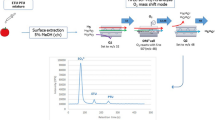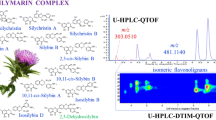Abstract
Supercritical fluid chromatography was used to resolve and determine ginkgolic acids (GAs) and terpene lactones concurrently in ginkgo plant materials and commercial dietary supplements. Analysis of GAs (C13:0, C15:0, C15:1, and C17:1) was carried out by ESI (−) mass detection. The ESI (−) spectra of GAs simply displayed only the [M-H]− pseudo-molecular ions, and selected ion monitoring (SIM) for those ions was used for the quantification. Analysis of terpene lactones (ginkgolides A, B, C, J and bilobalide) was complicated by in-source collision-induced dissociation (IS-CID) in the ESI source. Thus, MS analysis could be influenced by the fragmentation pattern produced by the IS-CID. However, it was established that the fragmentation pattern, measured by ion survival yield (ISY), was independent of analyte concentration or matrix at a fixed cone voltage in the ESI source. Therefore, MS with SIM mode was applicable for the analysis of these analytes. The reported method provided consistent and sensitive analysis for the analytes of interest. The LOQs and LODs were determined to be below 100 and 40 ng/mL for GAs and 1 μg/mL and 400 ng/mL for terpene lactones, respectively. Intra- and inter-day precisions were found to be satisfactory with RSDs being below 5.2 %. Analyte recoveries ranged from 87 to 109 %. The developed method was successfully applied to the analysis of 11 ginkgo plant samples and 8 dietary supplements with an analysis time of less than 12 min.






Similar content being viewed by others
References
van Beek TA, Montoro P. Chemical analysis and quality control of Ginkgo biloba leaves, extracts, and phytopharmaceuticals. J Chromatogr A. 2009;1216(11):2002–32. doi:10.1016/j.chroma.2009.01.013.
Gawron-Gzella A, Marek P, Chanaj J, Matlawska I. Comparative analysis of pharmaceuticals and dietary supplements containing extracts from the leaves of Ginkgo biloba L. Acta Pol Pharm. 2010;67(4):335–43.
Association for Healthcare Philanthropy AHP. Annual Report. 2011.
Wu Z, Smith JV, Paramasivam V, et al. Ginkgo biloba extract EGb 761 increases stress resistance and extends life span of Caenorhabditis elegans. Cell Mol Biol. 2002;48(6):725–31.
Guan H, Ren H, Zhang W, et al. Interactions of pharmacokinetic profile of different parts from Ginkgo biloba extract in rats. J Ethnopharmacol. 2014;155(1):758–68.
Ding S, Dudley E, Plummer S, Tang J, Newton RP, Brenton AG. Fingerprint profile of Ginkgo biloba nutritional supplements by LC/ESI-MS/MS. Phytochemistry. 2008;69(7):1555–64. doi:10.1016/j.phytochem.2008.01.026.
Ding S, Dudley E, Plummer S, Tang J, Newton RP, Brenton AG. Quantitative determination of major active components in Ginkgo biloba dietary supplements by liquid chromatography/mass spectrometry. Rapid Commun Mass Spectrom. 2006;20(18):2753–60. doi:10.1002/rcm.2646.
Avula B, Sagi S, Gafner S, et al. Identification of Ginkgo biloba supplements adulteration using high performance thin layer chromatography and ultra high performance liquid chromatography-diode array detector-quadrupole time of flight-mass spectrometry. Anal Bioanal Chem. 2015;407(25):7733–46. doi:10.1007/s00216-015-8938-1.
Pandey R, Chandra P, Arya KR, Kumar B. Development and validation of an ultra high performance liquid chromatography electrospray ionization tandem mass spectrometry method for the simultaneous determination of selected flavonoids in Ginkgo biloba. J Sep Sci. 2014;37(24):3610–8.
Harnly JM, Luthria D, Chen P. Detection of adulterated Ginkgo biloba supplements using chromatographic and spectral fingerprints. J AOAC Int. 2012;95(6):1579–87. doi:10.5740/jaoacint.12-096.
Demirezer LO, Buyukkaya A, Ucakturk E, Kuruuzum-Uz A, Guvenalp Z, Palaska E. Adulteration determining of pharmaceutical forms of Ginkgo biloba extracts from different international manufacturers. Rec Nat Prod. 2014;8(4):394–400. 397 pp.
Chen P, Ozcan M, Harnly J. Chromatographic fingerprint analysis for evaluation of Ginkgo biloba products. Anal Bioanal Chem. 2007;389(1):251–61. doi:10.1007/s00216-007-1386-9.
Xie P, Chen S, Liang Y-Z, Wang X, Tian R, Upton R. Chromatographic fingerprint analysis—a rational approach for quality assessment of traditional Chinese herbal medicine. J Chromatogr A. 2006;1112(1–2):171–80. doi:10.1016/j.chroma.2005.12.091.
Nakanishi K. Terpene trilactones from Gingko biloba: from ancient times to the 21st century. Bioorg Med Chem. 2005;13(17):4987–5000. doi:10.1016/j.bmc.2005.06.014.
Andersen NH, Christensen NJ, Lassen PR, et al. Structure and absolute configuration of ginkgolide B characterized by IR- and VCD spectroscopy. Chirality. 2010;22(2):217–23. doi:10.1002/chir.20730.
Liu X-G, Qi L-W, Fan Z-Y, et al. Accurate analysis of ginkgolides and their hydrolyzed metabolites by analytical supercritical fluid chromatography hybrid tandem mass spectrometry. J Chromatogr A. 2015;1388:251–8. doi:10.1016/j.chroma.2015.02.031.
Crellin KC, Sible E, Van Antwerp J. Quantification and confirmation of identity of analytes in various matrices with in-source collision-induced dissociation on a single quadrupole mass spectrometer. Int J Mass Spectrom. 2003;222(1–3):281–311. doi:10.1016/S1387-3806(02)01023-0.
Li X-J, Wang Y-Q, Yang J, et al. Semi-quantitative determination of monocarboxylate forms of ginkgolide B in plasma by UPLC-MS. Anal Bioanal Chem. 2015;407(14):4121–9. doi:10.1007/s00216-015-8628-z.
Wang M, Zhao J, Avula B, et al. High-resolution gas chromatography/mass spectrometry method for characterization and quantitative analysis of ginkgolic acids in Ginkgo biloba plants, extracts, and dietary supplements. J Agric Food Chem. 2014;62(50):12103–11. doi:10.1021/jf503980f.
Koch E, Noeldner M, Leuschner J. Reproductive and developmental toxicity of the Ginkgo biloba special extract EGb 761 in mice. Phytomedicine. 2013;21(1):90–7. doi:10.1016/j.phymed.2013.09.004.
Posadzki P, Watson L, Ernst E. Herb-drug interactions: an overview of systematic reviews. Br J Clin Pharmacol. 2013;75(3):603–18. doi:10.1111/j.1365-2125.2012.04350.x.
van Beek TA. Ginkgolides and bilobalide: their physical, chromatographic and spectroscopic properties. Bioorg Med Chem. 2005;13(17):5001–12. doi:10.1016/j.bmc.2005.05.056.
van Beek TA. Chemical analysis of Ginkgo biloba leaves and extracts. J Chromatogr A. 2002;967(1):21–55. doi:10.1016/S0021-9673(02)00172-3.
Wang L, Jia Y, Pan Z, Mo W, Hu B. Direct analysis of alkylphenols in Ginkgo biloba leaves by thermochemolysis-gas chromatography/mass spectrometry in the presence of tetramethylammonium hydroxide. J Anal Appl Pyrolysis. 2009;85(1+2):66–71. doi:10.1016/j.jaap.2008.09.014.
Schoetz K. Quantification of allergenic urushiols in extracts of Ginkgo biloba leaves, in simple one-step extracts and refined manufactured material (EGb 761). Phytochem Anal. 2004;15(1):1–8. doi:10.1002/pca.733.
Biber A, Koch E. Bioavailability of ginkgolides and bilobalide from extracts of Ginkgo biloba using GC/MS. Planta Med. 1999;65(2):192–3. doi:10.1055/s-2006-960467.
Fourtillan JB, Brisson AM, Girault J, et al. Pharmacokinetic properties of bilobalide and ginkgolides A and B in healthy subjects after intravenous and oral administration of Ginkgo biloba extract (EGb 761). Therapie. 1995;50(2):137–44.
Lang Q, Yak HK, Wai CM. Selective dissolution and one step separation of terpene trilactones in ginkgo leaf extracts for GC-FID determination. Talanta. 2001;54(4):673–80. doi:10.1016/S0039-9140(01)00317-4.
Deng F, Zito SW. Development and validation of a gas chromatographic-mass spectrometric method for simultaneous identification and quantification of marker compounds including bilobalide, ginkgolides and flavonoids in Ginkgo biloba L. extract and pharmaceutical preparations. J Chromatogr A. 2003;986(1):121–7. doi:10.1016/S0021-9673(02)01921-0.
Krzek J, Czekaj JS, Rzeszutko W, Ekiert RJ. Validation of capillary gas chromatographic method for determination of bilobalide and ginkgolides A, B, C in Ginkgo biloba dry and liquid extracts. Acta Pol Pharm. 2007;64(4):303–10.
Yao X, Zhou G, Tang Y, et al. UPLC-PDA-TOF/MS coupled with multivariate statistical analysis to rapidly analyze and evaluate Ginkgo biloba leaves from different origin. Drug Test Anal. 2014;6(3):288–94. doi:10.1002/dta.1477.
Yao X, Zhou G-S, Tang Y-P, Qian Y-F, Guan H-L, Pang H, Zhu S, Mo X, Su S-L, Jin C, Qin Y, Qian D-W, Duan J-A. Simultaneous quantification of flavonol glycosides, terpene lactones, biflavones, proanthocyanidins, and ginkgolic acids in Ginkgo biloba leaves from fruit cultivars by ultrahigh-performance liquid chromatography coupled with triple quadrupole mass spectrometry. BioMed Res Int. 2013; 582591, 582511 pp. doi:10.1155/2013/582591.
Avula B, Wang Y-H, Smillie TJ, Khan IA. Column liquid chromatography/electrospray ionization-time of flight-mass spectrometry and ultraperformance column liquid chromatography/mass spectrometry methods for the determination of ginkgolides and bilobalide in the leaves of Ginkgo biloba and dietary supplements. J AOAC Int. 2009;92(2):645–52.
van Nederkassel AM, Vijverman V, Massart DL, Vander Heyden Y. Development of a Ginkgo biloba fingerprint chromatogram with UV and evaporative light scattering detection and optimization of the evaporative light scattering detector operating conditions. J Chromatogr A. 2005;1085(2):230–9. doi:10.1016/j.chroma.2005.05.110.
Tang C, Wei X, Yin C. Analysis of ginkgolides and bilobalide in Ginkgo biloba L. extract injections by high-performance liquid chromatography with evaporative light scattering detection. J Pharm Biomed Anal. 2003;33(4):811–7. doi:10.1016/S0731-7085(03)00309-1.
Ganzera M, Zhao J, Khan IA. Analysis of terpenelactones in Ginkgo biloba by high performance liquid chromatography and evaporative light scattering detection. Chem Pharm Bull. 2001;49(9):1170–3. doi:10.1248/cpb.49.1170.
Thompson J, Strode III B, Taylor LT, van Beek TA. Supercritical fluid chromatography of ginkgolides A, B, C and J and bilobalide. J Chromatogr A. 1996;738(1):115–22. doi:10.1016/0021-9673(96)00064-7.
Bicchi C, Balbo C, Rubiolo P. Packed column supercritical fluid chromatography of sesquiterpene lactones with different carbon skeletons. J Chromatogr A. 1997;779(1 + 2):315–20. doi:10.1016/S0021-9673(97)00406-8.
ICH (2005) Validation of analytical procedures: Text and methodology Q2(R1). ICH Harmonized tripartite guidelines. Geneva, Switzerland
Li R, Shen Y, Zhang X, Ma M, Chen B, van Beek TA. Efficient purification of ginkgolic acids from Ginkgo biloba leaves by selective adsorption on Fe3O4 magnetic nanoparticles. J Nat Prod. 2014;77:571–5.
Yang X-M, Zhang X-L, Chen Y-C, Liu F. LC method for determination of ginkgolic acids in mice plasma and its application to a pharmacokinetic study. Chromatographia. 2009;69:593–6.
Li X-J, Yang K, Du G, Xu L, Lan K. Understanding the regioselective hydrolysis of ginkgolide B under physiological environment based on generation, detection, identification, and semi-quantification of the hydrolyzed products. Anal Bioanal Chem. 2015;407(26):7945–56. doi:10.1007/s00216-015-8963-0.
Sun Y, Li W, Fitzloff JF, van Breemen RB. Liquid chromatography/electrospray tandem mass spectrometry of terpenoid lactones in Ginkgo biloba. J Mass Spectrom. 2005;40(3):373–9.
Bruno F, Curini R, Di Corcia A, Nazzari M, Samperi R. Method development for measuring trace levels of penicillins in aqueous environmental samples. Rapid Commun Mass Spectrom. 2001;15(16):1391–400. doi:10.1002/rcm.381.
Kuki A, Irsai I, Nagy L, et al. In-source collision induced dissociation study of polyethers cationized by alkali metal ions. Int J Mass Spectrom. 2013;334:38–42. doi:10.1016/j.ijms.2012.10.004.
Li LYT, Campbell DA, Bennett PK, Henion J. Acceptance criteria for ultratrace HPLC-tandem mass spectrometry: quantitative and qualitative determination of sulfonylurea herbicides in soil. Anal Chem. 1996;68(19):3397–404. doi:10.1021/AC960375W.
Acknowledgments
This research is supported in part by “Science Based Authentication of Dietary Supplements” funded by the Food and Drug Administration grant number 1U01FD004246-05 and The United States Department of Agriculture, Agricultural Research Service, Specific Cooperative Agreement No. 58-6408-1-603-07.
Author information
Authors and Affiliations
Corresponding author
Ethics declarations
Conflict of Interest
The authors declare that they have no competing interests.
Rights and permissions
About this article
Cite this article
Wang, M., Carrell, E.J., Chittiboyina, A.G. et al. Concurrent supercritical fluid chromatographic analysis of terpene lactones and ginkgolic acids in Ginkgo biloba extracts and dietary supplements. Anal Bioanal Chem 408, 4649–4660 (2016). https://doi.org/10.1007/s00216-016-9544-6
Received:
Revised:
Accepted:
Published:
Issue Date:
DOI: https://doi.org/10.1007/s00216-016-9544-6




